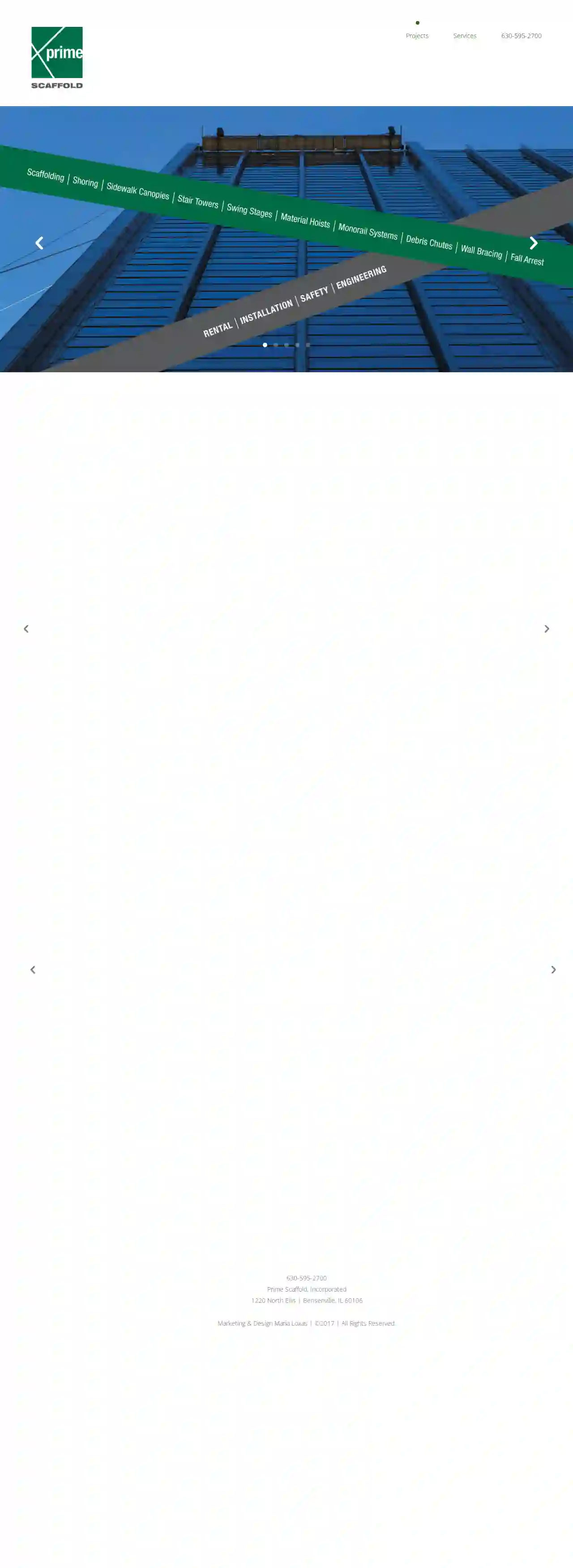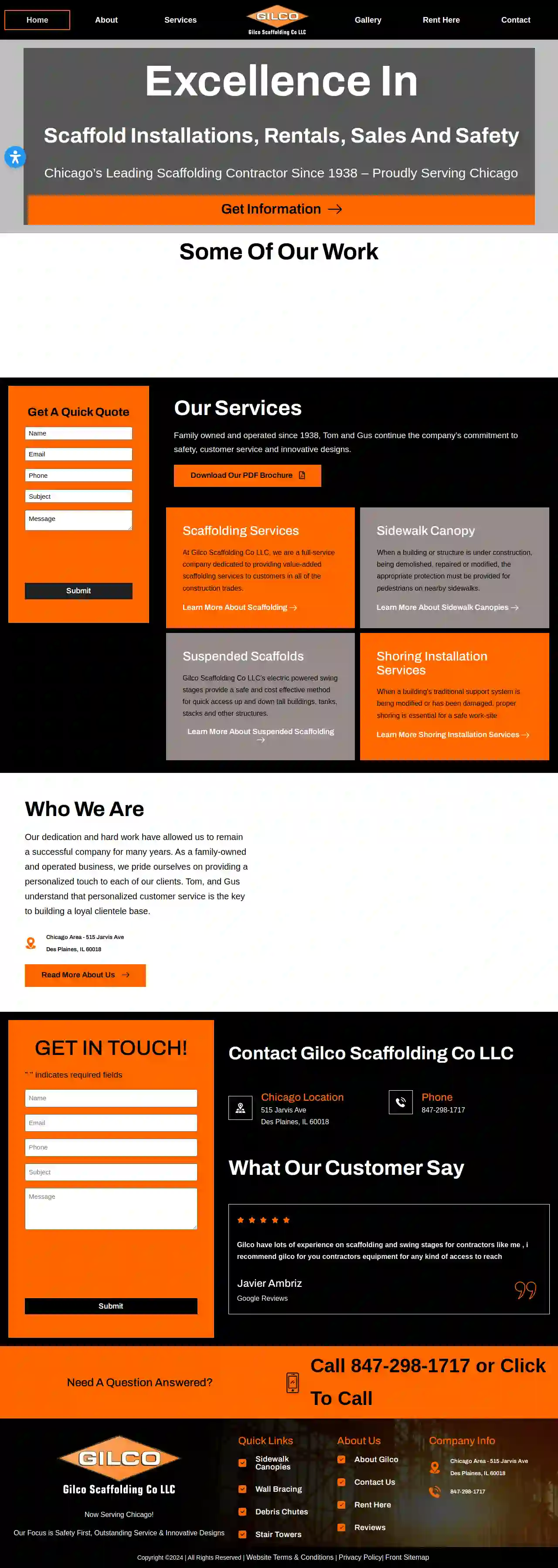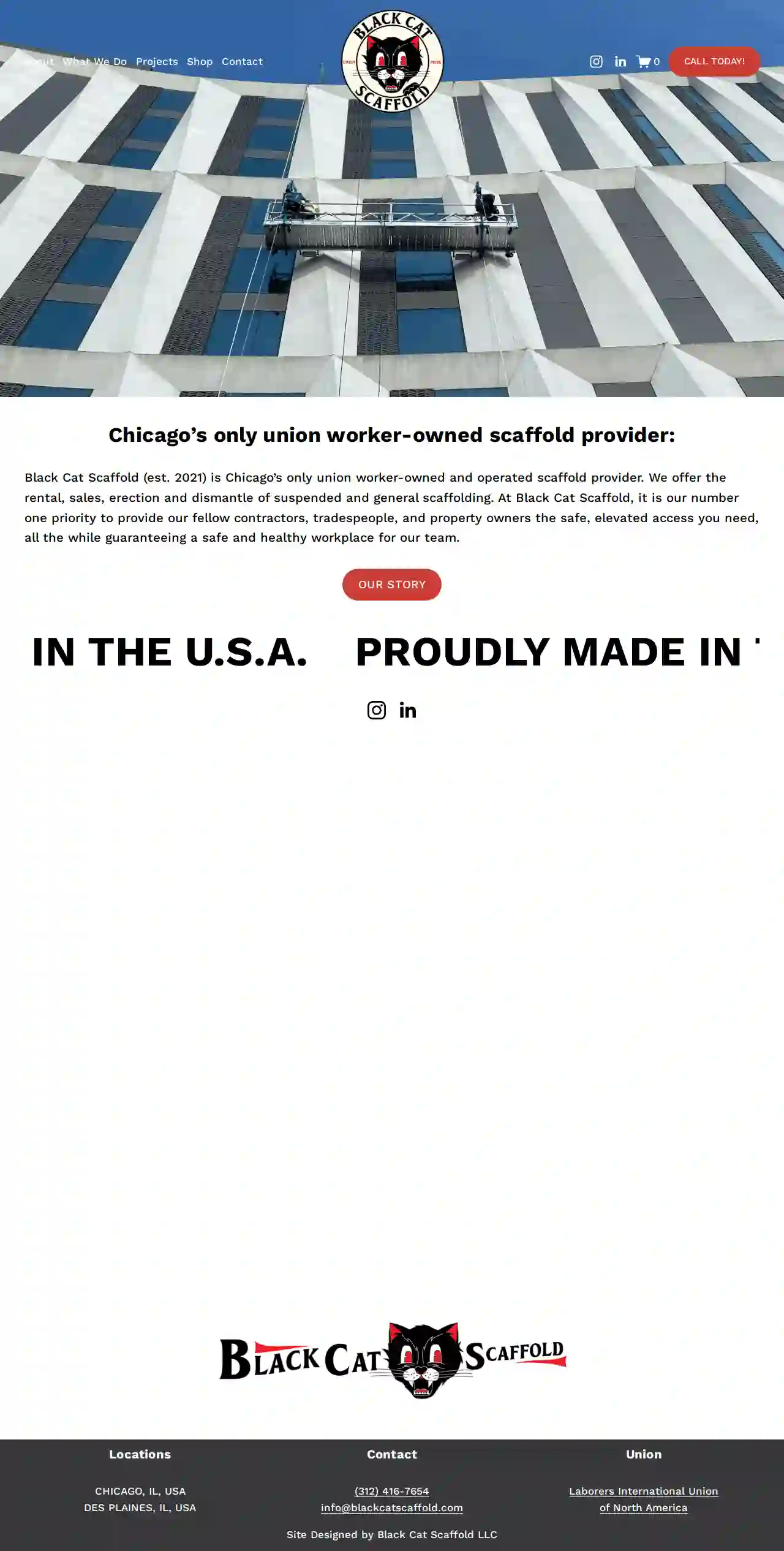Scaffolding Companies Fairfield
Find top Scaffolding Contractors in Fairfield
Get 3 FREE Scaffold Services quotes for your project today! Compare profiles, reviews, accreditations, portfolio, etc... and choose the best offer.

Prime Scaffold Inc
4.19 reviews1220 North Ellis, Bensenville, 60106, USPrime Scaffold has been planning, designing, engineering and installing scaffolding systems in the Chicago metropolitan area for over 35 years. With a team of fully engaged and well-trained installers, they provide innovation, attention to detail, safety and excellent customer service. Their expertise meets specific project needs, working on large and small projects for local buildings, museums, airports, ballparks, skyscrapers and famous landmarks. They are OSHA compliant and have experience with complex projects such as the Garfield Park Conservatory and 401 North Michigan Avenue.
- Services
- Why Us?
- Gallery
Get Quote
JC Licht Benjamin Moore Paint & Decor Store Addison
4.7139 reviews1500 N. Addison Ave., Addison, 60102, USShop JC Licht Online or at one of our 48 locations in Chicagoland. Your local, neighborhood Benjamin Moore dealer. Our Story JC Licht has been serving the Chicagoland area for over 100 years. We are a family-owned and operated business that is committed to providing our customers with the best possible service and selection. We offer a wide variety of Benjamin Moore paints, stains, and finishes, as well as a full line of window treatments, wallpaper, and hardware. We also offer a variety of services, including color consultations, in-home estimates, and professional installation. Our Mission Our mission is to provide our customers with the best possible experience. We want to make sure that you are happy with your purchase and that you feel confident in your decision. We are committed to providing you with the highest quality products and services, and we are always here to answer your questions and help you find the perfect solution for your needs. Our Team Our team is made up of experienced professionals who are passionate about helping you create the home of your dreams. We are committed to providing you with the best possible service and we are always here to answer your questions and help you find the perfect solution for your needs.
- Services
- Why Us?
- Gallery
Get Quote
Gilco Scaffolding Co
3.316 reviews515 Jarvis Ave, Des Plaines, 60018, USExcellence In Scaffold Installations, Rentals, Sales And Safety Chicago’s Leading Scaffolding Contractor Since 1938 – Proudly Serving Chicago Our Services Family owned and operated since 1938, Tom and Gus continue the company’s commitment to safety, customer service and innovative designs. Scaffolding Services At Gilco Scaffolding Co LLC, we are a full-service company dedicated to providing value-added scaffolding services to customers in all of the construction trades. Who we are Our dedication and hard work have allowed us to remain a successful company for many years. As a family-owned and operated business, we pride ourselves on providing a personalized touch to each of our clients. Tom, and Gus understand that personalized customer service is the key to building a loyal clientele base.
- Services
- Why Us?
- Gallery
Get Quote
Black Cat Scaffold
52 reviewsChicago, USBlack Cat Scaffold (est. 2021) is Chicago’s first union worker-owned and operated scaffold provider offering the rental, sales, erection and dismantle of suspended and general scaffolding. At Black Cat Scaffold, it is our number one priority to provide our fellow contractors, tradespeople, and property owners the safe, elevated access you need, all the while guaranteeing a safe and healthy workplace for our team. As an American, minority-owned (MBE Certified), small business, we offer superior client focus and competitive pricing. Unlike most in our local industry, Black Cat Scaffold offers majority American-made swing stage and scaffold equipment through our US (Ohio) manufacturers. At Black Cat Scaffold it is our belief that when union laborers have ownership in the business they work for, they are able to provide top tier services and expertise. With a collective 25 years of experience in the Chicago Building Trades, this is our pledge to every client. Thank you for considering Black Cat Scaffold for your future access needs!
- Services
- Why Us?
- Accreditations
- Gallery
Get Quote
SafwayAtlantic by BrandSafway - Chicago
4.19 reviewsChicago, IL, 123 Access Solutions Blvd, 60601, USBrandSafway is a leading provider of access solutions, including scaffolding, aerial work platforms, and forming and shoring equipment. With a strong commitment to safety, quality, and customer satisfaction, BrandSafway offers a wide range of services tailored to meet the unique needs of clients across various industries. Their team of experienced professionals works closely with clients to understand their requirements and deliver customized solutions that enhance efficiency and productivity. BrandSafway is dedicated to providing innovative access solutions that ensure safe and efficient project execution.
- Services
- Why Us?
- Accreditations
- Our Team
- Testimonials
Get Quote
Bracing Systems Construction Supplies and Equipment
4.329 reviewsHanover Park, 4N350 Old Gary Ave, 60133, USWe understand your challenge: To get all your equipment and supplies reliably and on time, while maintaining good profit margins. As your most reliable source of construction equipment and contractor supplies, Bracing Systems can supply your company with the products to get your job done right and under budget. Whether you are a general contractor, masonry contractor, concrete contractor or a contractor in another specialized trade, we stock it for customer pick up or can deliver it right to the job site. Our service department has a huge inventory of parts in stock to repair your Lull, Mustang, JLG, Pettibone, or Manitou Forklift, Essick Mixer, Hydro-Mobile Scaffolding, Stihl Power Equipment, Multiquip Compactors /Troweling Machines and many more brands of construction equipment. We offer convenient customer pick up at our 2 suburban locations or excellent on time delivery to your jobsite.
- Services
- Why Us?
- Gallery
Get Quote
International Equipment Inc
25218 S State St, Crete, 60417, USInternational Equipment, Inc. is a leading supplier and installer of high-quality scaffold equipment that enables your crews to work productively and safely at heights. Wherever you need your scaffolding to take you International Equipment has the right equipment for your project. Servicing all of the Midwest, International Equipment responds quickly to the needs of our customers, even during emergencies. We are a devoted team committed to providing the right product for your project with a personal touch that many larger competitors cannot match. We offer designs in augmented or virtual reality as well as 3D allowing you to see your design as it will appear when installed. You won’t pay for estimator’s guess work or extra rental charges for equipment you don’t need. Parts lists and installation costs are accurate with our estimating systems. With our resources and extensive inventory of equipment we are able to provide you with a variety of options to buy or rent. From project planning and installation of equipment to rigorous safety standards and training, International Equipment is there for you from start to finish.
- Services
- Why Us?
- Gallery
Get Quote
Walmart Supercenter
4.11404 S. Old Rand Rd, Lake Zurich, IL, 60047, USWalmart is a multinational retail corporation that operates a chain of hypermarkets, discount department stores, and grocery stores. With a strong commitment to providing quality products at affordable prices, Walmart aims to make everyday items accessible to everyone. The company's mission is to save people money so they can live better. Walmart offers a wide range of services including grocery shopping, electronics, home goods, and more. Their team consists of dedicated professionals who strive to provide excellent customer service. Walmart has multiple locations and serves various cities, ensuring convenience for customers across the country. They prioritize customer satisfaction and offer various trust factors such as a return policy, customer support, and a commitment to sustainability. Walmart also partners with various organizations to support local communities and promote environmental sustainability.
- Services
- Why Us?
- Accreditations
- Our Team
- Testimonials
- Gallery
Get Quote
Menards
4.3766 reviews123 Main St, CityName, 00000, USMenards is a leading home improvement store that offers a wide range of products and services to help customers enhance their homes. With a strong commitment to customer satisfaction, Menards strives to provide the best shopping experience possible. From building materials to kitchen and bath, electrical, plumbing, paint, and more, Menards has everything you need for your home improvement projects. Their dedicated team is always ready to assist with any questions or needs you may have.
- Services
- Why Us?
Get Quote
Menards
4.3Chicago, USMenards is a home improvement store that offers a wide range of products and services for homeowners, contractors, and DIY enthusiasts. With a long history of providing quality products and excellent customer service, Menards has become a trusted name in the industry.
- Services
- Why Us?
Get Quote
Over 2,353+ Scaffolding Companies on our directory
Our scaffolding experts operate in Fairfield and beyond!
ScaffoldingHQ has curated and vetted Top Scaffolding Contractors near Fairfield. Find the most reliable pro today.
Frequently Asked Questions About Scaffolding Companies
- Regulations: Local regulations often specify minimum inspection intervals.
- Project Type and Duration: Long-term projects or those in challenging environments may require more frequent inspections.
- Weather Conditions: Severe weather (storms, high winds) can necessitate additional inspections.
- Any Alterations or Modifications: Any changes to the scaffolding structure require re-inspection.
- Hire Professionals: Just like erection, dismantling should be done by qualified and experienced scaffolding erectors.
- Reverse the Erection Process: The dismantling process should generally follow the reverse order of erection.
- Clear the Area: Ensure the area below is free from people and obstacles.
- Lower Materials Safely: Use ropes or other safe methods to lower dismantled components to the ground.
- Inspect Components: As components are removed, inspect them for damage and store them properly for future use.
- Encroaches onto public property (sidewalks, roads): Permits are usually needed from the local council or highway authority.
- Exceeds a certain height: Scaffolding above a specified height often requires a permit.
- Is erected in a conservation area or near a listed building: Special considerations and permits may apply.
How often should scaffolding be inspected?
How do I dismantle scaffolding safely?
What is a scaffolding hoist?
Do I need a permit for scaffolding in the USA?
How often should scaffolding be inspected?
- Regulations: Local regulations often specify minimum inspection intervals.
- Project Type and Duration: Long-term projects or those in challenging environments may require more frequent inspections.
- Weather Conditions: Severe weather (storms, high winds) can necessitate additional inspections.
- Any Alterations or Modifications: Any changes to the scaffolding structure require re-inspection.
How do I dismantle scaffolding safely?
- Hire Professionals: Just like erection, dismantling should be done by qualified and experienced scaffolding erectors.
- Reverse the Erection Process: The dismantling process should generally follow the reverse order of erection.
- Clear the Area: Ensure the area below is free from people and obstacles.
- Lower Materials Safely: Use ropes or other safe methods to lower dismantled components to the ground.
- Inspect Components: As components are removed, inspect them for damage and store them properly for future use.
What is a scaffolding hoist?
Do I need a permit for scaffolding in the USA?
- Encroaches onto public property (sidewalks, roads): Permits are usually needed from the local council or highway authority.
- Exceeds a certain height: Scaffolding above a specified height often requires a permit.
- Is erected in a conservation area or near a listed building: Special considerations and permits may apply.